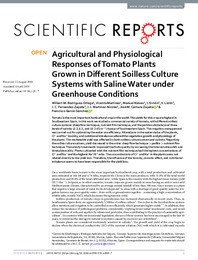Please use this identifier to cite or link to this item:
https://hdl.handle.net/11000/33480Full metadata record
| DC Field | Value | Language |
|---|---|---|
| dc.contributor.author | Cámara-Zapata, José-María | - |
| dc.contributor.author | Rodríguez Ortega, Wilbert Michael | - |
| dc.contributor.author | Martínez López, Vicente | - |
| dc.contributor.author | Nieves, Manuel | - |
| dc.contributor.author | Simón Vilella, Inmaculada | - |
| dc.contributor.author | Fernández Zapata, Juan Carlos | - |
| dc.contributor.author | Martinez Nicolas, Juan Jose | - |
| dc.contributor.author | García-Sanchez, Francisco | - |
| dc.date.accessioned | 2024-10-14T11:37:29Z | - |
| dc.date.available | 2024-10-14T11:37:29Z | - |
| dc.date.created | 2019-05 | - |
| dc.identifier.citation | Scientific Reports volume 9, Article number: 6733 | es_ES |
| dc.identifier.issn | 2045-2322 | - |
| dc.identifier.uri | https://hdl.handle.net/11000/33480 | - |
| dc.description.abstract | Tomato is the most important horticultural crop in the world. The yields for this crop are highest in Southeastern Spain. In this work we studied a commercial variety of tomato, with different soilless culture systems (deep flow technique, nutrient film technique, and the perlite substrate) and three levels of salinity (2.2, 6.3, and 10.2 dS·m−1) typical of Southeastern Spain. The irrigation management was carried out for optimizing the water use efficiency. Alterations in the water status of the plants, Cl− and Na+ toxicity, and nutritional imbalances altered the vegetative growth and physiology of the plants. The marketable yield was affected by both soilless culture system and salinity. Regarding the soilles culture system, yield decreased in the order: deep flow technique > perlite > nutrient film technique. The salinity treatments improved the fruits quality by increasing the total soluble solids and titratable acidity. Plants cultivated with the nutrient film technique had the highest concentrations of Cl− and Na+ and the highest Na+/K+ ratio. The concentrations of Cl− and Na+ in the plants were not related directly to the yield loss. Therefore, the influence of the toxicity, osmotic effect, and nutritional imbalance seems to have been responsible for the yield loss. | es_ES |
| dc.format | application/pdf | es_ES |
| dc.format.extent | 13 | es_ES |
| dc.language.iso | eng | es_ES |
| dc.publisher | Nature Research | es_ES |
| dc.rights | info:eu-repo/semantics/openAccess | es_ES |
| dc.rights | Attribution-NonCommercial-NoDerivatives 4.0 Internacional | * |
| dc.rights.uri | http://creativecommons.org/licenses/by-nc-nd/4.0/ | * |
| dc.title | Agricultural and Physiological Responses of Tomato Plants Grown in Different Soilless Culture Systems with Saline Water under Greenhouse Conditions | es_ES |
| dc.type | info:eu-repo/semantics/article | es_ES |
| dc.relation.publisherversion | https://doi.org/10.1038/s41598-019-42805-7 | es_ES |

View/Open:
Scientific RepoRts.pdf
3,14 MB
Adobe PDF
Share:
.png)
